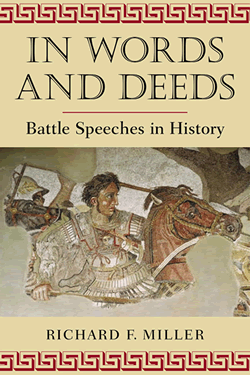Richard F. Miller. In Words and Deeds: Battle Speeches in History Lebanon, NH: University Press of New England, 2008. 424 pages.

Richard F. Miller’s In Words and Deeds: Battle Speeches in History is a unique book. While it does contain excerpts from more than 90 speeches, it is more than just transcribed words. Miller has classified the speeches into categories involving their content (e.g. recruitment, instructional, surrender) and their relation to the stage of the battle (i.e. pre, midst, post). The speechmakers are all combatants. There are no quotes from politicians like Winston Churchill or Franklin Roosevelt. So when the book claims to be “the first systematic classification of battle speeches” (inside cover), it is correct.
This systematic breakdown can be either intriguing or frustrating depending on the reader’s goal. Those who are searching for an analysis of speeches from a particular time period, person, or war will find the speeches of interest scattered across 400+ pages. Yet, for the readers who are interested in the topic of the battle speech, they will find an enriching analysis of the different forms buttressed by examples throughout history. The book is structured in a categorical format. As each chapter progresses, a speech or two is given, and Miller reviews the content, purpose, audience, and effect. Each category of speeches consists of sub-categories as well. For example, the first chapter reviewing history retold through battle speeches is broken down into historical narratives concerning the unit, religion, society, and politics.
The analysis is thorough and typically satisfying. Throughout the book, Miller brings to light rarely printed speeches and new insights into popular speeches. For example, Lieutenant Colonel Tim Collins’s pre-battle speech given to the First Battalion, Royal Irish Regiment on March 19, 2003 is one that found popularity on the Internet through email forwards (This reviewer recalls seeing the speech at least a dozen times in his inbox). In the speech, Collins states, “We are going to Iraq to liberate and not to conquer” (p. 20). Collins goes on to give his men explicit detail on how to treat the people in the country. He stresses the need to focus on the real enemy: Saddam Hussein and his forces. In addition, “Iraq is steeped in history; it is the site of the Garden of Eden, of the Great Flood and the birthplace of Abraham. Tread lightly there. . .” (p. 20). Readers were typically relieved that men with a philosophy like Collins’s were leading the troops. Miller reveals more to the speech though. Collins was in charge of a mini-coalition that consisted of British, Canadians, Australians, Nepalese, South Africans, Zimbabweans, Fijians, Americans, and even some Mexicans (p. 25). With this multi-national, multi-religious group, Collins was able to bring up historical events in Iraq that they would all recognize: Garden of Eden, the Great Flood, and Abraham. Even atheists are familiar with these stories and they would realize the need to “tread lightly” in the country. This makes the speech truly geared toward soldiers of the world.
Miller also looks at the deeds of the speechmakers. These deeds may be coupled with words. In the battle against the Nervii (57 BC), Julius Caesar gave a pre-battle speech in which he urged his troops “to live up to their tradition of bravery” (p. 229). When his legions appeared to be near defeat, Caesar picked up a shield and moved to the front lines with his men. This gave the troops “fresh heart and hope; each man wanted to do his best under the eyes of his commander-in-chief. . .” (p. 230). Caesar showed that “gestures, acts, and the omission of acts will be interchangeable with the spoken word” (p. 230).
The words analyzed are all western in origin save for one speech by Osama bin Laden at the end of the book. More than half of the 90+ speeches are from Americans and half of those are from the Civil War. Major historical figures get as many as three of their speeches analyzed (e.g. Julius Caesar, George Washington, Robert E. Lee), but Napoleon has by far the most speeches reviewed at 11. Though it appears lopsided, the book offers a wide variety speechmakers quoting Napoleon on one page and then an obscure colonel from the Civil War on the next. The categorization is an effective one allowing Miller to publish other books, or perhaps volumes, in the future.
